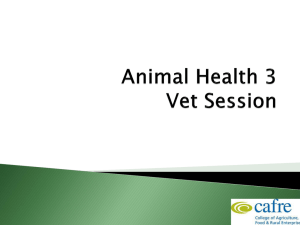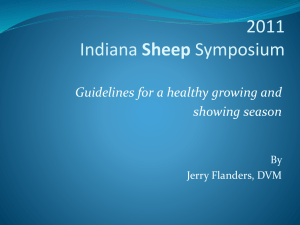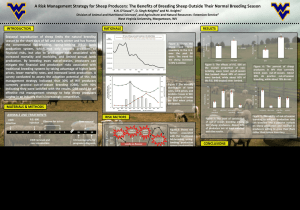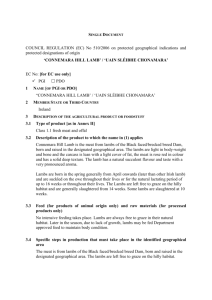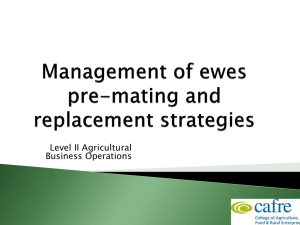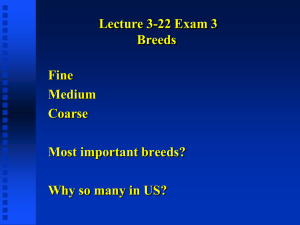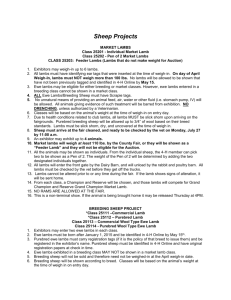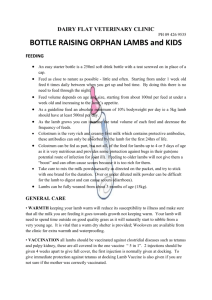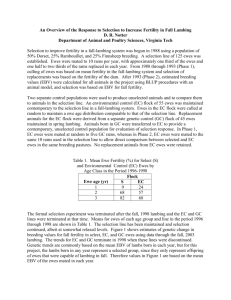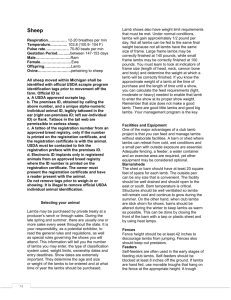Genetics Paper - Cynthia Clark`s Eportfolio
advertisement
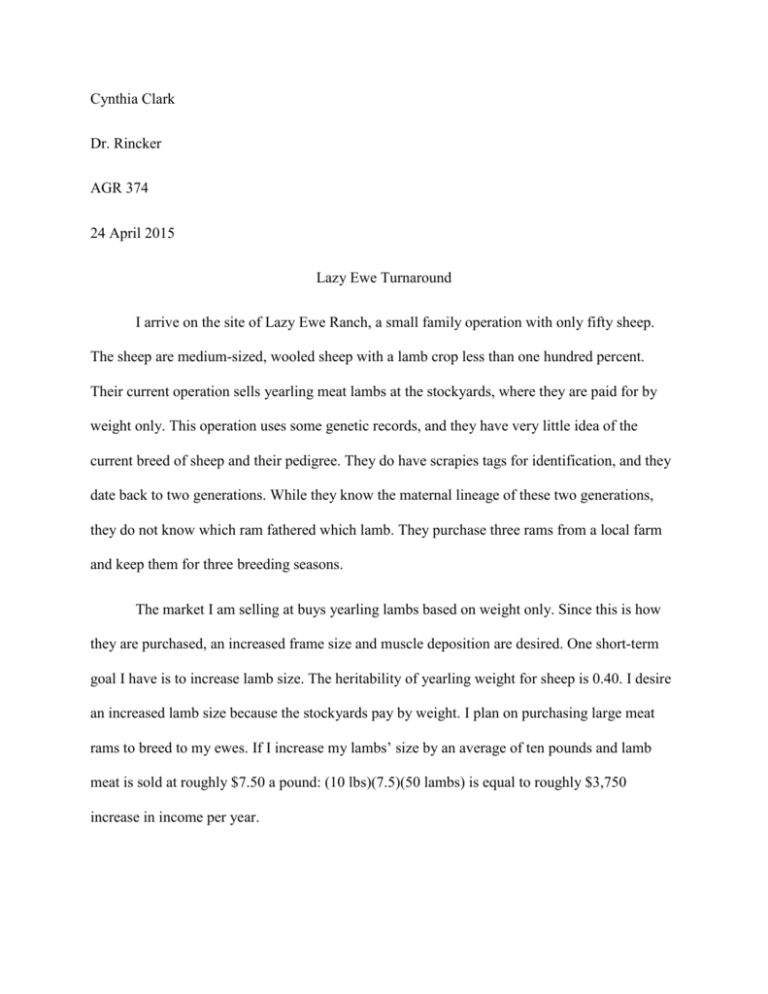
Cynthia Clark Dr. Rincker AGR 374 24 April 2015 Lazy Ewe Turnaround I arrive on the site of Lazy Ewe Ranch, a small family operation with only fifty sheep. The sheep are medium-sized, wooled sheep with a lamb crop less than one hundred percent. Their current operation sells yearling meat lambs at the stockyards, where they are paid for by weight only. This operation uses some genetic records, and they have very little idea of the current breed of sheep and their pedigree. They do have scrapies tags for identification, and they date back to two generations. While they know the maternal lineage of these two generations, they do not know which ram fathered which lamb. They purchase three rams from a local farm and keep them for three breeding seasons. The market I am selling at buys yearling lambs based on weight only. Since this is how they are purchased, an increased frame size and muscle deposition are desired. One short-term goal I have is to increase lamb size. The heritability of yearling weight for sheep is 0.40. I desire an increased lamb size because the stockyards pay by weight. I plan on purchasing large meat rams to breed to my ewes. If I increase my lambs’ size by an average of ten pounds and lamb meat is sold at roughly $7.50 a pound: (10 lbs)(7.5)(50 lambs) is equal to roughly $3,750 increase in income per year. Another short-term goal I have is to transition to a hair breed of sheep. Since finding a dual-purpose breed is nearly impossible, (larger meat breeds do not have the wool quality, while wool breeds do not have the size) and the meat market is less risky, I plan on transitioning to hair sheep. Since these lambs are used for meat, I would have to pay to have them sheared. In an effort to save time and money, I will try to breed my current ewes to large, hair meat breeds, such as Katahdins and Dorpers. The heritability of staple length is 0.50. After a few generations, I should have hair sheep only, and will not have to worry about the timely and costly process of shearing, as the sheep will shed on their own. The only long term goal I have is to reach a lamb crop of one hundred and eighty percent. This lamb crop goal is set at one hundred and eighty to account for lamb loss, and the occasional single lamb. If an animal is capable of producing two, possibly three offspring for almost the same nutritional demands as one offspring, why not try to take advantage of it? The more lambs are born, the more meat can be taken to market. I will select a ram breed that is known for throwing twins, and the occasional triplet, such as a Katahdin. When figuring the math, looking at a one hundred and eighty percent lamb crop, this means that ninety lambs will be born. With there being more lambs, it means that I can be more selective with which genetics I would like to pass on to my future livestock. The current breeding plan is to keep the top eighty percent of the ewes, and to cull the rest, there is no defined system, but the ewes are chosen based on memory of performance. There is no scale kept on the ranch, the lambs are eyeballed. Ewes are not watched during lambing, so there is no lambing ease scale. The ewes are not nutritionally flushed prior to breeding, and are not fed any grain during their lactation. Ewes are not monitored to see mothering ability. With these poor practices, there is no reliable way to determine which ewes should be culled. Selection intensity when the top eighty percent are kept is at 0.35. A possible contributor to the unusually low lamb crop percent is the treatment of the lambs themselves. The ewes are all kept in the same pen during lambing, and are not separated from each other at all. This leads to confusion, and sometimes the lambs are not recorded to the correct mothers. These lambs are not monitored to ensure that they have had a chance to nurse within the twenty four hour period to obtain the colostrum they need for their immune systems. In addition to this, the lambs are not given any vaccinations whatsoever. The rams are switched out after three breeding seasons, and purchased from a local farm. The rams are bought purely on an economic stance, cheap is considered better. These rams are medium sized wooled breed. The rams are fed mostly grain, and are overweight. This is thought to contribute to a lack of stamina on the rams’ part, and an overall reduced lamb crop. The assumed selection intensity for these rams are at the top eighty percent. Selection intensity for the rams is equal to 0.35. The breeding plan I would like to instate includes keeping the top fifty percent of ewes. Selection intensity would increase to 0.80. The ewes will be judged based on lamb size, number of lambs born, mothering ability, fertility and ease of birthing. I will purchase a scale for lamb weight, and keep record of who sired each lamb. I will continue to use Scrapies tags to identify my sheep, and tag the lambs shortly after being born. The rams will wear breeding belts for easy identification, as well as separating my ewes into three groups. This will increase the accuracy of my records, by knowing which ram fathered which lambs. The virgin ewes will be bred to a smaller ram, to try to prevent dystocia problems. The other two groups will be separated by frame size, and the larger of the ewes will be bred to the biggest ram, and the smaller group will be bred to a medium sized ram. Prior to breeding, the ewes will be nutritionally flushed. This will help increase pregnancy rates, as well as potentially boosting the number of multiple births. During lactation, the ewes will have some grain supplemented to prevent a loss of body condition, and to be able to provide the lambs with all the required nutrients. When the ewes begin to show signs of labor, they will be placed in a small pen by themselves, called a jug. They will be monitored during the birthing process, and I will make sure that the lambs receive their colostrum. This pen will also make it easy to identify which lamb(s) belong to which ewe, and they can be tagged prior to being grouped together. These jugs will also help determine the mothering ability of the ewe. In addition to all this, the lambs will be vaccinated with CD/T and Bo-Se to prevent common illnesses. The rams will be changed out every year, and will be chosen for their performance record and genetics, at the top twenty five percent of their breed. Selection intensity will increase to 1.27. The rams I am selecting are from JM Katahdins. The owners of JM Katahdins are members of the Katahdin Breeder’s Association, and are listed on their website as a reputable farm, and provider of genetic material. They have been bred for parasite resistance, a high twinning/triplet rate, highly muscled, growth on pasture, and large frame size. While on Lazy Ewe Ranch, these rams’ diet will consist mostly of forages, but will have limited grain supplement when breeding. These rams are being chosen for three main reasons. The increased lamb size will result in more meat available to take to the stockyards. The hair genes will cut out shearing costs, and save time. Finally, the twinning/triplet rate will increase, meaning more lambs will be taken to market. Overall, the breeding plan I plan on instating will result in larger lambs, who, over time, will be hair sheep with a high twinning/triplet rate. In addition to improved genetics, the environmental effects will also positively improve genetic change. With maintaining genetic records properly, culling decisions can be made fairly and wisely With these new policies put into effect, the rate of genetic change will increase.


